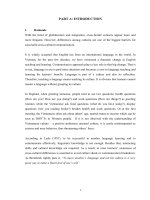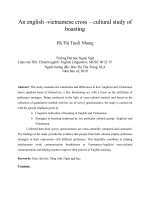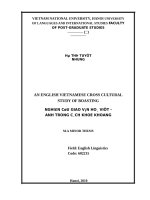An english -vietnamese cross – cultural study of boasting
Bạn đang xem bản rút gọn của tài liệu. Xem và tải ngay bản đầy đủ của tài liệu tại đây (1.51 MB, 8 trang )
An english -vietnamese cross – cultural study of
boasting
Hà Thị Tuyết Nhung
Trường Đại học Ngoại Ngữ
Luận văn ThS. Chuyên ngành: English Linguistics; Mã Số: 60 22 15
Người hướng dẫn: Đào Thị Thu Trang, M,A
Năm bảo vệ: 2010
Abstract: This study examines the similarities and differences in how Anglicist and Vietnamese
native speakers boast of themselves, a face threatening act, with a focus on the utilization of
politeness strategies. Being conducted in the light of cross-cultural analysis and based on the
collection of quantitative method with the use of survey questionnaires, the study is carried out
with the special emphasis given to:
Linguistic realization of boasting in English and Vietnamese.
Strategies in boasting employed by two particular cultural groups: Anglicist and
Vietnamese.
Collected data from survey questionnaires are cross-culturally compared and contrasted.
The findings of the study provide the evidence that people from both cultures employ politeness
strategies in their expressions with different preference. This hopefully contribute to helping
interlocutors avoid communication breakdowns in Vietnamese-Anglicist cross-cultural
communication and helping teachers improve their process of English teaching.
Keywords: Giao văn hóa; Tiếng Anh; Ngôn ngữ học.
Content:
4
TABLE OF CONTENTS
* Certificate of originality of study project report
*Acknowledgements
*Abstract
*Table of contents
*Abbreviations
* List of tables
* List of figures
i
ii
iii
iv
vi
vii
viii
PART I: INTRODUCTION
1. Rationale
2. Scope of the study
3. Aims of the study
4. Methodology
5. Design of the study
PART II: DEVELOPMENT
CHAPTER 1: THEORETICAL BACKGROUND
1.1. Language, culture and cross-cultural communication
1.1.1. Language, culture in communication
1.1.2. Language and culture in cross-cultural communication
1.2. Speech act
1.2.1. What is a speech act?
1.2.2. Classification of speech acts
1.2.3. Boasting as a speech acts
1
1
2
2
3
3
5
5
5
5
6
7
7
8
10
5
1.3. Politeness
1.3.1. What is politeness?
1.3.2. Face and Politeness
1.3.3. Politeness strategies
CHAPTER 2: DATA ANALYSIS AND FINDINGS
2.1. Advisable topics to boast
2.2. Politeness strategies realized in boasting
2.3. Use of strategies in boasting as seen from communicating
partners' parameters
2.3.1. Data analysis
2.3.2 Major similarities and differences
2.4. Use of strategies in boasting as seen from informants'
parameters
2.4.1. Data analysis
2.4.2 Major similarities and differences
PART III: CONCLUSION
1. Review of the findings
2. Implications for cross – cultural communication
3. Suggestions for further research
REFERENCES
APPENDICES
11
11
12
14
16
16
18
20
20
28
28
29
31
33
33
33
33
35
9
PART I: INTRODUCTION
1. RATIONALE
Nowadays, as English becomes an international language in many fields, the
number of Vietnamese learners of English has increased. However, it is recognized that
many Vietnamese – English interactions have experienced communication breakdown
due to misinterpretations and misunderstandings.
Language plays an important role in our life. Language is not only for
communication but also for cultural exchange among nations. It is difficult to imagine
what our lives would be like without language. Language is a sign that makes human
different from all other species in the animal kingdom. People use it to communicate their
ideas and thoughts to express their feelings such as anger, love, hate… and to convey
their hopes and dreams.
Cross – cultural communication is an interesting and attractive field for us to find
out the similar and different language when studying speech acts such as greeting,
advising, promising among countries in the world. Comparisons of speech acts from
different cultures have revealed that the same speech acts may be realized differently
across cultures, following social norms of usage which are specific to the given speech
community.
In real – life conversations, people show different aspects of lives through
diversified formal and informal speech. Among them, lots of people can’t wait to tell us
all how fantastic they are, how they are good at this and even better than that. They claim
all manner of wild and outrageous things. They may claim to be enlightened, wise, highly
intellectual and they might tell you that they are so popular that you should be honored
they chose you to spend their day with. This is the way people boast and big themselves
up.
In the process of learning a foreign language, learners of English have to get to
know a different culture. They sooner or later realize the presence of cross – cultural
10
differences between English and Vietnamese. There were many studies about how
English and Vietnamese differ from each other in the ways of expressing sympathy,
promise, excitement, enjoyment… However, the study of boasting has not been paid
much attention to. With the hope of contributing a little to successful cross – cultural
communication, this paper with a limited scope of research on English and Vietnamese
similarities and differences in boasting has been written to help speakers of English
observe the nature of boasting, how to boast, when to boast in real – life situations.
2. SCOPE OF THE STUDY
Although paralinguistic (speed, loudness, pitch…) and extralinguistic (facial
expressions, postures, proximity…) factors, to some extent, play a decisive role in
interpersonal communication, they are beyond the scope of this study. The study only
focuses on the verbal aspects of the act of boasting.
The study is limited to the data obtained from the survey questionnaire on ways of
boasting in three socially differentiated situations. The questionnaires were given to 50
Vietnamese and 50 English native speakers. Basing on their completion of the
questionnaires, the author used the utterances for contrastive analysis. Among the various
participants’ social relationship, the author only examines the relationship between close
friends, colleagues, bosses-employees, and the people they dislike.
3. AIMS OF THE STUDY
The research is intended to investigate major similarities and differences in the
ways of boasting by the Vietnamese and English in given situations. Its goal is to provide
a deep insight into cross – cultural communication between two languages and cultures,
thus help to avoid communication breakdown in English – Vietnamese cross-cultural
interaction.
In order to gain this overall target, the study will:
discover the acts of boasting based on the theories of speech acts and politeness.
investigate advisable topics that the English and Vietnamese prefer to boast about.
investigate the use of politeness strategies in boasting through relationship with
certain partners and under certain variables (age, gender, marital status, living
place…) through some specific situations.
11
find out major similarities and differences in how the English and Vietnamese
boast of themselves verbally.
raise teachers’ and learners’ cross – cultural awareness of boasting in cross –
cultural communication in order to avoid potential conflicts.
4. METHODOLOGY
The study is mainly conducted by the quantitative method with the use of survey
questionnaires. The questionnaires are designed with both close-ended and open-ended
questions. In the open-ended part, DCT (Discourse Completion Task) questions are
designed and used. DCT is regarded as an effective method to collect a wide range of
similarities and differences between Vietnamese and English, and more importantly
between the two cultures in showing objection within the scope of the study.
In general, all the considerations, comments and remarks in this thesis are based on:
Relevant publication
Survey questionnaires
Statistics, description and analysis of the collected data
Consultation with supervisor
Discussion with Vietnamese and English native colleagues
Personal observation
5. DESIGN OF THE STUDY
The thesis consists of three parts:
PART I: INTRODUCTION
This part includes the rationale, aims, scope of the study, methodology and design
of the study.
PART II: DEVELOPMENT
This part is divided into two chapters:
Chapter 1: Theoretical background
In this chapter, theories of language, culture and communication are mentioned. A
theory of speech act is also mentioned with the view of boasting as a speech act. The
definition of politeness, politeness strategies are critically discussed.
Chapter 2: Data analysis and findings
12
In this chapter, data analysis and findings of the study are presented with the
illustrations of tables and charts. The similarities and differences of boasting between
Vietnamese and English languages and cultures are drawn from detailed and critical
analysis of data.
PART III: CONCLUSION
Summary of the major findings, implications for cross-cultural communication
and suggestions for further research are presented in this part.
44
REFERENCES
1. Austin J.L. (1962). How to do things with words. CUP, London-Oxford-New York.
2. Brown, P. and Levinson, S. (1987). Politeness: Some Universals in Language Usage.
Cambridge University Press.
3. Delahunty G.P., Gurvey J.J. (1994). Language Grammar and Communication. MC
Grow-Hill, Inc.
4. Leech G. W. (1983). Principles of Pragmatics. London and New York, Longman.
5. McArthur, T. and McArthur, R. (1996). The Oxford Companion to the English
6. NguyÔn Quang (2003). Giao tiÕp néi v¨n hãa vµ giao v¨n
hãa. Nhµ xuÊt b¶n §HQGHN, Hµ Néi.
7. Nguyen Quang (2005). Lecture notes for cross-cultural communication. CFL-VNU,
Hanoi.
8. Richards, J.C. and Schmidt, R.W. (1983). Language and Communication. London and
New York: Longman.
9. Searle J, R. (1969). Speech acts-An Essay in the Philosophy of Language. Cambridge
University Press.
10. Thomas, J. (1995). Meaning in Interaction: An Introduction to Pragmatics. New
York. Longman.
11. Yule, G. (1996). Pragmatics. Ofxord University Press.
12. Verderber R. (1981). Communicative. Wadsworth Publishing Company.
Language. Oxford University Press.
13. Watts, R.J. (2003). Politeness. Cambridge University Press.
14. Wierbicka, A. (1987). English Speech Act Verbs. Academic Press.
15.









